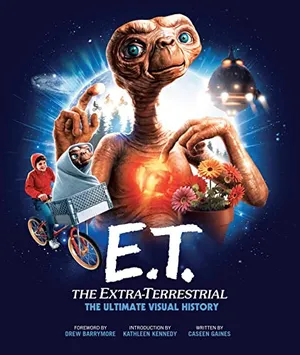Why the Legacy of ‘E.T.’ Endures, 40 Years Later
A new book offers a behind-the-scenes look at the iconic Steven Spielberg movie
:focal(2095x1436:2096x1437)/https://tf-cmsv2-smithsonianmag-media.s3.amazonaws.com/filer_public/90/21/9021a93d-e44a-4e8e-af51-eaf90107f070/gettyimages-159835836.jpg)
In 1982, a short, brown alien with a glowing fingertip won the hearts of movie-goers around the world. Now, 40 years after E.T. the Extra-Terrestrial first hit theaters and became an instant classic, a new book offers a behind-the-scenes look at the making of the beloved film.
Written by pop culture historian Caseen Gaines, E.T. the Extra-Terrestrial: The Ultimate Visual History explores how director Steven Spielberg and his crew brought some of the movie’s most iconic moments to life.
With exclusive new interviews with members of the cast and crew, as well as never-before-seen photos, storyboards and concept art, the book pulls back the curtain on the blockbuster film, which at one point was the highest-grossing movie ever made.
The movie follows 10-year-old Elliott (played by Henry Thomas) as he meets and befriends an alien who got left behind on Earth. When Elliott first encounters the orphaned extraterrestrial, he’s understandably terrified. But, over time, the two become chummy, with Elliott eventually uttering the memorable line, “I’m keeping him.” Despite their connection, Elliott must find a way to get E.T. back home.
Shot from the perspective of a child, the movie delicately addresses complex topics like divorce, loneliness and sibling dynamics. As film critic Sean Burns writes for WBUR, E.T. remains “one of the purest and most emotionally direct of all American movies, with not a whit of adult condescension nor any self-protecting irony.”
E.T.: the Extra Terrestrial: The Ultimate Visual History
Documenting the complete history of E.T., the book explores Spielberg’s initial inspiration for the story, the challenging shoot, and the record-breaking success, as well as the film’s endurance, examining the merchandising it inspired and the reasons E.T. holds a permanent place in the hearts of movie fans the world over.
A section of E.T. the Extra-Terrestrial: The Ultimate Visual History details how technicians and special effects artists built the physical version of E.T. in just six months, a massive undertaking on such a short timeline. They did such a good job that, as A.A. Dowd writes for the Washington Post, viewers may forget that E.T. is a “suit augmented with animatronics.”
“Some of [the movie’s] remarkable success has to be chalked up to E.T. himself,” Dowd writes. “He remains one of the most soulful, expressive special effects ever conceived … E.T. has personality and character and emotion, and he moves like a living thing. He seems genuinely alive.”
/https://tf-cmsv2-smithsonianmag-media.s3.amazonaws.com/filer_public/0a/fc/0afcb3ad-e9b1-4c8b-8ea9-3d88320d2fd3/et_uvh_in02.jpg)
The book also describes how innovators at Industrial Light and Magic got the iconic shot of E.T. and Elliott riding a bike through the air in front of a full moon. They created a model forest and miniature puppet figure riding a bicycle, then spent months outside in the dark to get the perfect telephoto shot of the full moon rising above the horizon.
“When looking at the moon in real life, it’s the size of your pinky fingernail when your arm is stretched out all the way,” says Michael Pangrazio, who worked as matte supervisor on the film, in the new book. “It’s pretty small, but ours is exaggerated … We wanted to show all the craters and detail. If we had created it with paint or cotton, or backlighting, it would have been too simplistic. We had to go for the real thing, and in the end, it paid off.”
Drew Barrymore, who was just 6 years old when Spielberg cast her in the role of Elliott’s little sister, Gertie, wrote the book’s forward; Kathleen Kennedy, the movie’s producer, wrote the introduction.
“The film still resonates because of how heartfelt it is,” Gaines tells Space.com’s Jeff Spry. “It still feels incredibly personal and intimate, like we are being let in on Elliott’s secret and lucky to be an observer to this special relationship he has with a visitor from outer space.”
A Note to our Readers
Smithsonian magazine participates in affiliate link advertising programs. If you purchase an item through these links, we receive a commission.
/https://tf-cmsv2-smithsonianmag-media.s3.amazonaws.com/accounts/headshot/SarahKuta.png)

/https://tf-cmsv2-smithsonianmag-media.s3.amazonaws.com/accounts/headshot/SarahKuta.png)